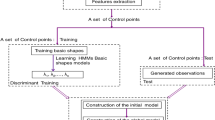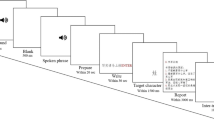Abstract
Earlier work by the author has established: (i) that cursive script can be synthesised out of individual characters by using polynomial merging functions which satisfy boundary conditions of continuity of the displacement functionsx(t) andy(t) for each character and their first and second derivatives; and (ii) that the procedure lends itself to a Bezier curve based formulation. This was done since cursive writing avoids discontinuities (of shape) between individual characters as well as discontinuities in pen movement.
We show here that even individual characters can be synthesised out of more primitive elements by using the same merging functions. We choose directed straight lines which we call shape vectors as basic elements for this. Script characters generally have shapes which are essentially straight segments alternating with ‘bends’ or regions of relatively high curvature. For a character withn bends, we need onlyn + 1 shape vectors. Thus, each script character needs only three to seven shape vectors, depending on its complexity.
The “character generation” shape vectors are derived from the original character by means of a simple procedure that identifies comparatively straight regions in it. These are then approximated to straight lines by linear regression and positioned to be tangential to the original curve. The synthesised version of this character is obtained by ‘merging’ or concatenating these vectors. The close fit between the original and resynthesised characters demonstrates that the shape vectors adequately characterise their identities and shapes. Data reduction ratios in the range of 15 to 25 are thus possible. This method thus shows good promise as a possible basis for script character recognition, and a recognition scheme based on it has yielded an accuracy of 94% for a vocabulary size of 67 words.
Similar content being viewed by others
References
Bezier P E 1972Numerical control — mathematics and applications (transl.) A R Forrest (London: John Wiley and Sons)
Eden M 1960 Handwriting and pattern recognition.IRE Trans. IT-8: 160–166
Eden M, Halle M 1961 The characterization of cursive writing.4th London Symposium on Information Theory (ed.) C Cheng (London: Butterworth)
Farag R F H 1979 Word-level recognition of cursive script.IEEE Trans. Comput. C-21: 172–175
Mokhtarian G, Mackworth A 1986 Scale-based description and recognition of planar curves and two-dimensional shapes.IEEE Trans. Pattern Anal. Machine Intell. PAMI-8: 34–43
Ramasubramanian V, Rao P V S 1988 Connected script synthesis by character concatenation — An overlap and weighted average formulation.Modern trends in information technology (Proc. SEARCC ’88) (eds) P V S Rao, P Sadanandan (New Delhi: Tata McGraw-Hill)
Rao P V S 1990a Word based recognition of cursive script.Proceedings of IAPR Workshop on Machine Vision Applications (Nov. 28–30) Tokyo
Rao P V S 1990b Cursive script recognition using neural nets.Proceedings of International Conference on Automation, Robotics and Computer Vision (ICARCV ’90) (Singapore: The Institution of Engineers)
Rao P V S, Ramasubramanian V 1991 Connected script synthesis by character concatenation — A Bezier curve formulation.Inst. Electron. Telecommun. Eng. 37: 485–493
Van der Gon D, Thuring J 1962 A handwriting simulator.Physiol. Med. Biol. 6: 407–414
Yasuhara M 1975 Experimental studies of handwriting process, Rep. Univ. Electron. Commun. 25-2, Science & Technology Section, pp. 233–254
Yasuhara M 1983 Identification and decomposition of fast handwriting system.IEEE Trans. Circuits Syst. CAS-30: 828–832
Author information
Authors and Affiliations
Rights and permissions
About this article
Cite this article
Rao, P. Shape vectors: An efficient parametric representation for the synthesis and recognition of hand script characters. Sadhana 18, 1–15 (1993). https://doi.org/10.1007/BF02811383
Received:
Revised:
Issue Date:
DOI: https://doi.org/10.1007/BF02811383




